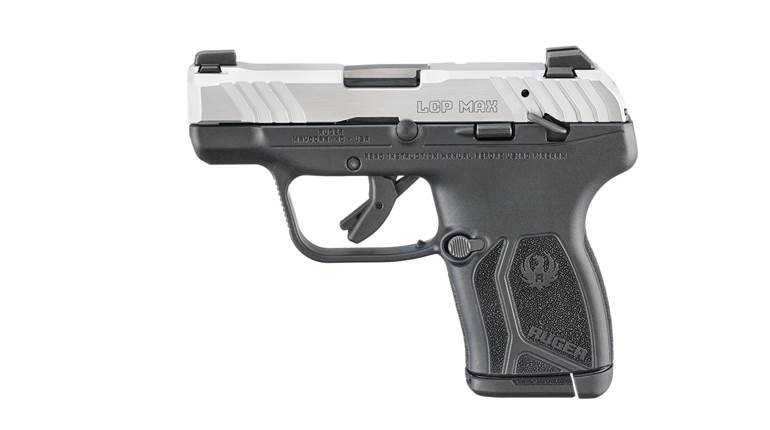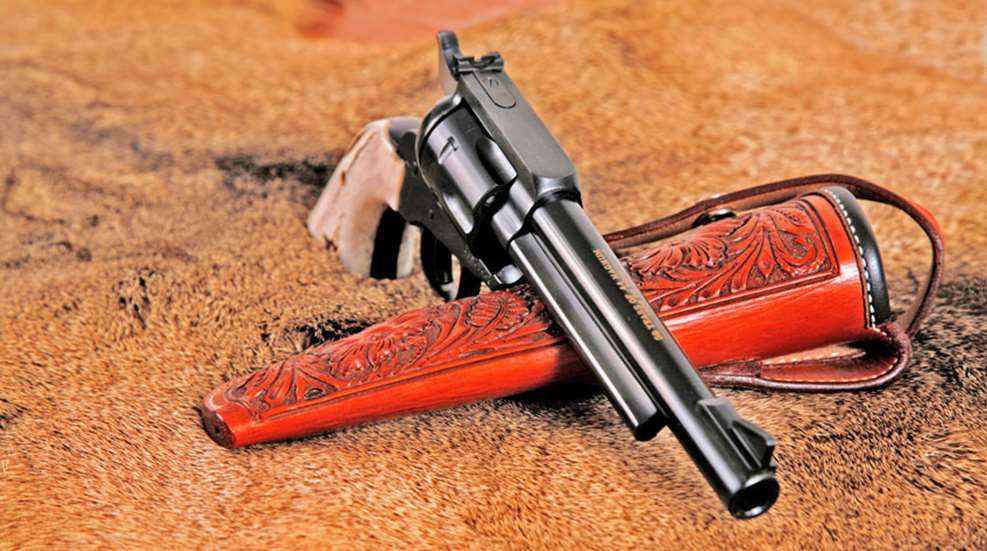
The term “holster” dates back to somewhere in the mid-17th century. Its origins are a combination of Dutch, Old English and German. The concept is actually seen in the Bible around 1,000 B.C., when a young David carried stones (ammo or a reload) in a leather pouch for his sling. However, in terms of packing a firearm, the concept of a holster was developed during the mid-17th century. The first holsters were pommel holsters—leather pouches hung or tied to the pommel of a saddle to make them instantly accessible to the rider. As smaller pistols were developed—the first pistols were comparatively large—most people stuffed them in a sash about the waist or in a pocket.
Holsters really took off after Samuel Colt started selling revolvers. Here again, the first ones were designed as pommel holsters. As the West was being opened up and settled, the need for instant access to a pistol became vital. New territory is always fraught with lawlessness, so if you wanted to stay alive, having a self-defense tool in immediate reach quickly became requisite.
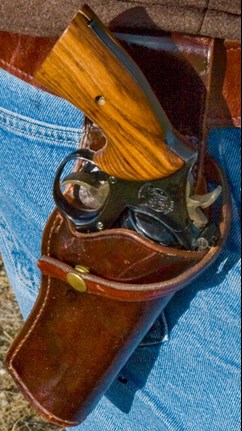 The first belt holsters appeared in the 1840s. Most early holsters protected the cylinder and barrel. Triggers were exposed because the revolvers were single action. Many included a piece of thong or a strap to retain the revolver when on a rank horse. Ammo pouches were relatively rare at the time, since most revolvers were cap-and-ball; if you needed a reload, a spare pistol—known popularly today as a “New York reload”—was how it was done. These first holsters were open at the top and bottom. As farmers and miners made their way west, they wanted a holster with a closed bottom to keep out dirt, debris and snow.
The first belt holsters appeared in the 1840s. Most early holsters protected the cylinder and barrel. Triggers were exposed because the revolvers were single action. Many included a piece of thong or a strap to retain the revolver when on a rank horse. Ammo pouches were relatively rare at the time, since most revolvers were cap-and-ball; if you needed a reload, a spare pistol—known popularly today as a “New York reload”—was how it was done. These first holsters were open at the top and bottom. As farmers and miners made their way west, they wanted a holster with a closed bottom to keep out dirt, debris and snow.
A decade later saw the first flap holsters—a holster made with an elongated back that folded over the pistol and snapped into place, thus maximizing the protection of the piece. Flap holsters became de reguerre for the military, not only to protect the pistol but to prevent its loss while on horseback. There was little need of a quick draw during most mid-19th century military encounters, so the flap was no detriment.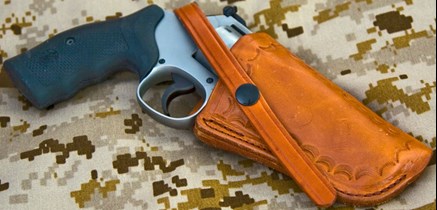
After the War Between the States, holster design returned to a variation of the open top, with either a strap or thong to restrain the pistol. Leather design had yet to progress to the point where the holster maker would form fit the leather to a specific pistol.
Westward immigration demanded two nearly opposite design features. The frontier was dirty, dusty and often wet. Cap-and-ball revolvers ruled the roost until Colt began making its iconic 1873 Single Action Army, and the percussion-fired pistols were especially subject to environment-induced failures. To complicate matters, speed of draw began to be more and more decisive in close interpersonal disputes. A compromise was worked out when the “Slim Jim” holster came along. Made from somewhat lighter-weight leather stock, the Slim Jim closely fitted the revolver’s profile and extended past the cylinder a bit, offering slightly better protection against the elements. The top remained open with the grip frame exposed, allowing for relatively quick access should arguments escalate to the point of flinging lead.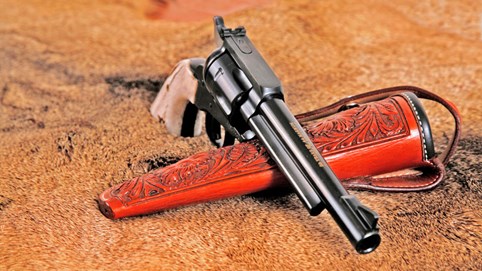
Mexican leatherworkers have long influenced everything from chaps to saddles, including holsters. The Mexican loop holster—with several variations—migrated northward and was quite popular during the latter two decades of the 1800s, well into the 1900s. Decorative carving and hardware were also characteristic of Mexican holsters—a feature still very much a part of today’s leather holsters.
The shoulder holster was first seen in the 1870s. With these the holster pouch is mounted on a loop of flat leather or fabric that wraps around the offside shoulder. Sometimes a keeper is fastened to the bottom of the pouch and retained by a belt or belt loop. In other examples, a thinner belt is attached to the shoulder loop near the top and goes across the back, under the strong-side shoulder and back to the shoulder loop. Some of these are set up to hold spare ammo or handcuffs. A variation of the shoulder holster is the Tanker or Chest rig. In these, the holster is more toward the front, and a strap wraps around the torso with another stabilizing strap going over the weak-side shoulder. One modern version of this is Simply Rugged Leather’s Chesty Pullerrig. With this the chest straps are separate from the holster pouch, meaning you can carry your handgun on your belt or set it up on your chest.
Leather holsters continued to be refined throughout the 20th century. A variety of retention devices were incorporated, primarily for law enforcement officers, who were expected to overpower the subjects resisting arrest. Often—too often—this would devolve into a scuffle whereby the subject would gain control of the officer’s sidearm followed by a tragic outcome. Thus came retention devices.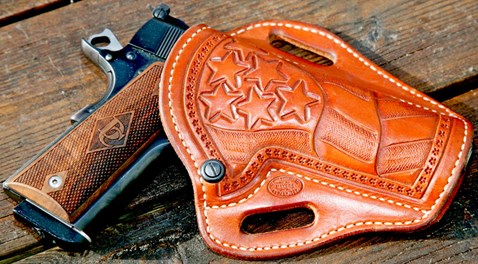
Straps with snaps, thumb-break snaps, clamshells and rigs designed to allow the handgun to be withdrawn from the holster in one direction only each had their adherents, as well as their day in the sunshine. Today—as far as leather is concerned—most of the rather quirky retention inventions have fallen by the wayside. A simple strap with a snap is usually the best alternative. There remain a few thumb-breaks, but those who carry a gun daily often find the thumb-break wears, and after a while wears out to the point that it either does not restrain the firearm, thereby making it useless as a retention device, or the snap freezes, keeping the gun in the holster when the wearer might desperately need it.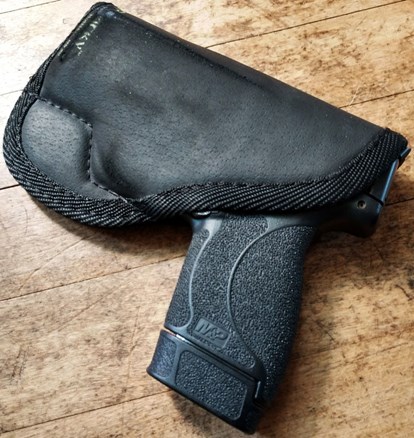
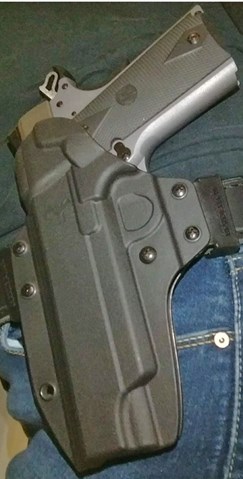 Along about the 1970s, some manufacturers began to market holsters made from synthetic materials instead of leather. Padded nylon was the first, I believe. It had the advantage of forming itself around the individual firearm so that one holster would work for a variety of similarly sized guns. Eventually most of these morphed into Cordura, a stronger material. If I recall correctly, the first composite holsters came out in the late 1970s. Kydex was the material of choice, and these could be molded to any specific firearm model for a perfect fit. As lights and lasers became permanent residents on pistols, these holsters were easily re-engineered to accommodate accessories. Today, I would opine that synthetic materials are bought by the public far more often than leather. The reason is simple: synthetic holsters are less expensive.
Along about the 1970s, some manufacturers began to market holsters made from synthetic materials instead of leather. Padded nylon was the first, I believe. It had the advantage of forming itself around the individual firearm so that one holster would work for a variety of similarly sized guns. Eventually most of these morphed into Cordura, a stronger material. If I recall correctly, the first composite holsters came out in the late 1970s. Kydex was the material of choice, and these could be molded to any specific firearm model for a perfect fit. As lights and lasers became permanent residents on pistols, these holsters were easily re-engineered to accommodate accessories. Today, I would opine that synthetic materials are bought by the public far more often than leather. The reason is simple: synthetic holsters are less expensive.
Choosing the best holster for you will be an individual matter. Some folks who live and carry in cooler climates may find a shoulder holster to be their best choice. Others with flat bellies will often opt for an inside-the-waistband holster. If you have the body shape for it, some opt for a bellyband holster, a sort of elastic body wrap that incorporates a holster in it. Some choose to use this with a T-shirt as concealment for a casual look.
Many who are new to carrying a concealed handgun regularly fail to understand that it will be necessary to modify their wardrobe to accommodate their piece. Think about it. Take a pound to a pound and a half of anything, hang it from your upper body by any means you choose, and see if you can keep it totally concealed, regardless of what you do physically, without making an accommodation with your wardrobe. Shirts and/or blouses will need to be upsized. Form-fitting clothes are out—as are shirttails. If you choose to carry a pocket gun—revolver or semi-automatic—make absolutely sure that the pockets of your carry garment are large enough and robust enough to stand up to the rigors of daily carry.
Sadly, the majority of you will make the cost of the holster the first—and perhaps the only—consideration. Several of my fellow handgunners have opined that they cannot understand why someone will spend upward of three to four grand on a tricked out custom handgun, then stuff it into a $25 holster. It happens a lot.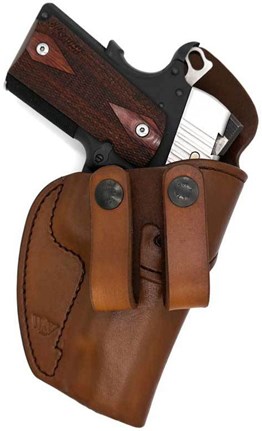 I confess I am very partial to leather for a holster material. There are several reasons beyond aesthetics‑leather holsters eventually conform to the wearer’s body, along with the gun it holds. If one takes a spill or is thrown into something substantial, leather has a certain amount of give. I once saw a shooter take a spill on an obstacle course while wearing a hard composite holster. Two things happened: first, he gave himself one heck of a bruise where the holster was rammed against his body, and two, the retention button got badly fouled with dirt. It was so bad he had to go offline, remove the holster and gun, pick and blow out the dirt, and spray the mechanism with silicone to get him through the rest of the course. His ultimate remedy was to replace the holster with an identical copy—just part of the cost of doing business.
I confess I am very partial to leather for a holster material. There are several reasons beyond aesthetics‑leather holsters eventually conform to the wearer’s body, along with the gun it holds. If one takes a spill or is thrown into something substantial, leather has a certain amount of give. I once saw a shooter take a spill on an obstacle course while wearing a hard composite holster. Two things happened: first, he gave himself one heck of a bruise where the holster was rammed against his body, and two, the retention button got badly fouled with dirt. It was so bad he had to go offline, remove the holster and gun, pick and blow out the dirt, and spray the mechanism with silicone to get him through the rest of the course. His ultimate remedy was to replace the holster with an identical copy—just part of the cost of doing business.
Some of the cheaper synthetic holsters are made of rubber-like material. This stuff is so flimsy that they can be ripped from the wearer’s body with a good yank. These rubberized rigs can be problematic in retaining the pistol. If it’s dry, the material can be so sticky that it’s a problem to draw the gun. In rainy weather, they can be so slick that the gun can fall out of it under stress.
Any retention device can fail. That means it can seize up and prohibit the draw, or fail to engage because of dirt, grime or breakage and not retain the pistol as it should. Another tick against hard synthetics is that they tend to be noisy. Pistols sometimes rattle in them; when the pistol is drawn or reholstered many do so with a noticeable “click” that can betray your position.
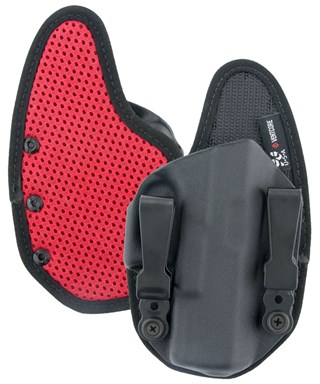 All that said, synthetic holsters made from Kydex seem to last forever. They don’t appear to wear out the way a well-used leather one will over a couple of decades. If you hang accessories on your pistol, a synthetic holster molded to accommodate your pistol and that specific accessory is just about mandatory. And, yes, synthetics are noticeably less expensive than many leather holsters.
All that said, synthetic holsters made from Kydex seem to last forever. They don’t appear to wear out the way a well-used leather one will over a couple of decades. If you hang accessories on your pistol, a synthetic holster molded to accommodate your pistol and that specific accessory is just about mandatory. And, yes, synthetics are noticeably less expensive than many leather holsters.
A caveat regardless of holster material—if your holster uses screws to tension the retention of the holster or attach it to a belt, those screws need to be Loctited in place. Prudent users will also check and re-torque those screws as part of their regular firearm cleaning and maintenance.
So how do you choose a holster? First you have to answer a few questions. Which firearm are you seeking to carry? Resist with everything you have to get one holster that handles more than one gun. If you expect to retain your pistol, regardless of activity, have it readily available in the exact same place every time you need it, protect it from the elements and last more than six months, you had better choose a holster made to fit your specific handgun and barrel length, as well as any accessories you may wish to hang on it.
Next, figure out how you are going to carry it. If you are going to carry it on your belt, do you plan on inside (IWB) or outside (OWB) your waistband? Appendix or hip? Be realistic. If you have a dunlop (“His belly dunlops over his belt”), an appendix carry is not the best alternative. Ditto for an IWB. If you have difficulty touching your toes, an ankle holster will ensure your gun is just out of reach at that critical moment you need it. Ladies, resist the temptation to carry your firearm in your purse. Double ditto for men—don’t have your wife or girlfriend pack your piece.
Just as when buying a gun, try to work out a way to try before you buy. An informed choice is the best choice.
Finally, a word about pocket guns, mouse guns, etc. Do not—I repeat, do not— simply stuff the pistol or revolver in a pocket and head on your merry way. Pockets collect dust, dirt, lint, throat lozenges, etc.—all of which can screw up the operation of your gat when you really don’t have time to address the problem. Keep you gun pocket clean and invest in a pocket holster. Such a holster is usually smooth on the inside and rough on the outside. There should not be a retention issue, and when you need your gun you want it in your hand right now. The rough surface clings to your pocket and ensures you do not draw your holster along with your pistol. When reholstering, you pull the holster from your pocket, insert your gun into it and put the entire assembly in the pocket as one—unless you like living dangerously. There are a number of pocket holsters out there; most are OK. The one I use is the Pocket Protector from Simply Rugged Holsters. My little S&W 342 PD has a more or less permanent home there, and has yet to show any fouling from pocket detritus.














